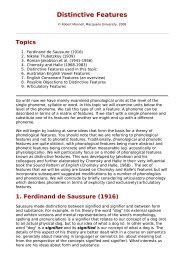Acoustic Waveforms Acoustic Waveforms Simple Harmonic Motion ...
Acoustic Waveforms Acoustic Waveforms Simple Harmonic Motion ...
Acoustic Waveforms Acoustic Waveforms Simple Harmonic Motion ...
You also want an ePaper? Increase the reach of your titles
YUMPU automatically turns print PDFs into web optimized ePapers that Google loves.
Speech <strong>Waveforms</strong> (3)<br />
• A much more detailed discussion of the<br />
following speech waveforms can be found<br />
on the topic web site at:-<br />
http://www.ling.mq.edu.au/speech/acoustics/waveforms/speech_waveforms.html<br />
Speech <strong>Waveforms</strong> (5)<br />
25<br />
2. Here we compare<br />
the weak murmur in<br />
a voiced stop /d/<br />
occlusion with the<br />
waveforms of /n/<br />
and /l/ and /j/, two<br />
approximates. Note<br />
the fairly simple<br />
waveforms for /d/<br />
and /n/ and the more<br />
complex waveforms<br />
for /l/ and /j/.<br />
Speech <strong>Waveforms</strong> (4)<br />
40 ms<br />
Speech <strong>Waveforms</strong> (6)<br />
1. One fricative /h/<br />
and three vowels<br />
with the start of<br />
each pitch cycle<br />
indicated by a<br />
vertical bar.<br />
The different<br />
vowels have<br />
different<br />
waveform<br />
patterns<br />
40 ms 27<br />
40 ms<br />
28<br />
Speech <strong>Waveforms</strong> (7)<br />
4. Here we can<br />
see different parts<br />
of the same /z/.<br />
Initially the<br />
amount of noise<br />
(randomness) is<br />
slight but it<br />
gradually<br />
strengthens to<br />
compete in<br />
strength with the<br />
regular (voiced)<br />
component.<br />
Speech <strong>Waveforms</strong> (8)<br />
26<br />
3. /f/ greatly amplified<br />
(is actually about the<br />
same amplitude as<br />
the low intensity part<br />
of /s/ marked with α).<br />
Note the random<br />
pattern for /f/ and /s/<br />
and the slight<br />
amounts of random<br />
pattern superimposed<br />
on a regular pattern<br />
for /v/ and /z/.<br />
5. Here we can<br />
see three CVC<br />
syllables each<br />
starting with /h/<br />
and ending with<br />
/d/. Its difficult to<br />
differentiate the<br />
three vowels<br />
from their pattern<br />
(which looks a<br />
little like a fish<br />
skeleton).<br />
40 ms 29<br />
30<br />
5
















